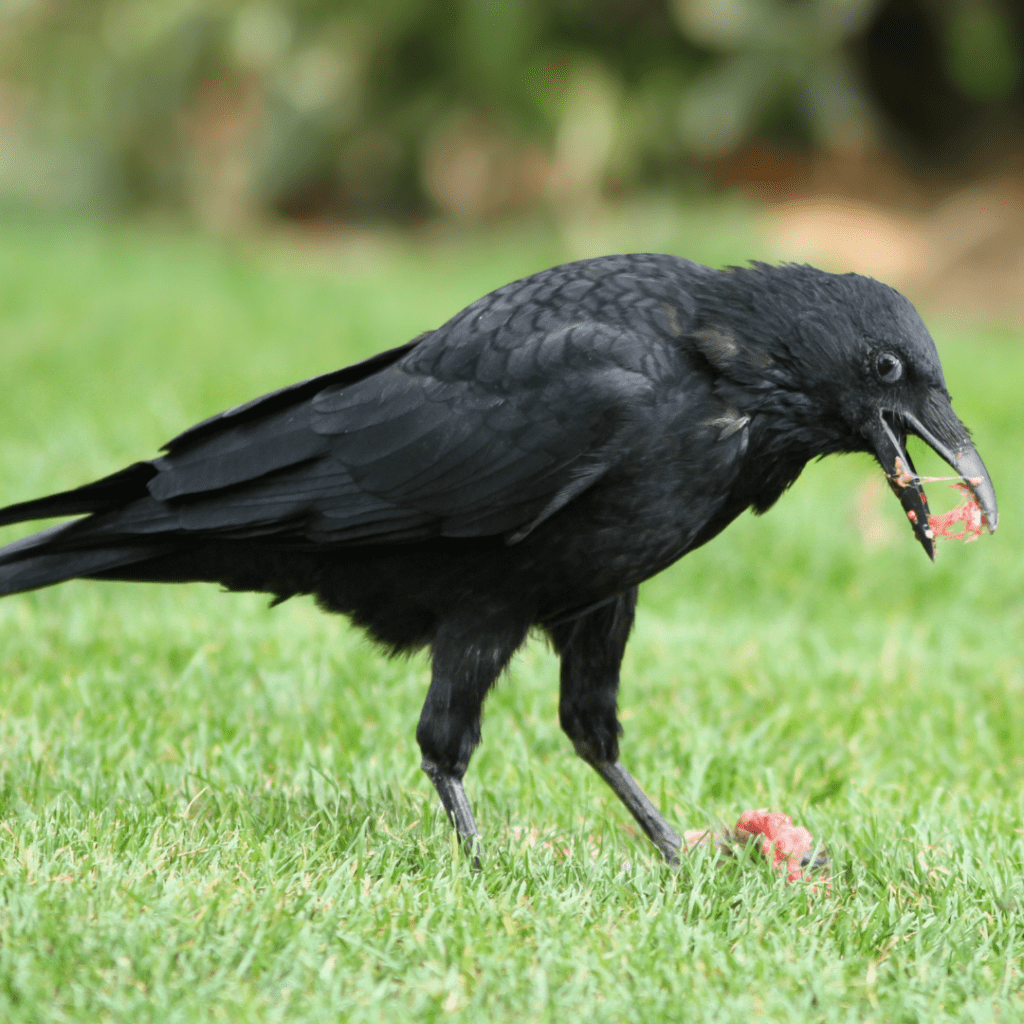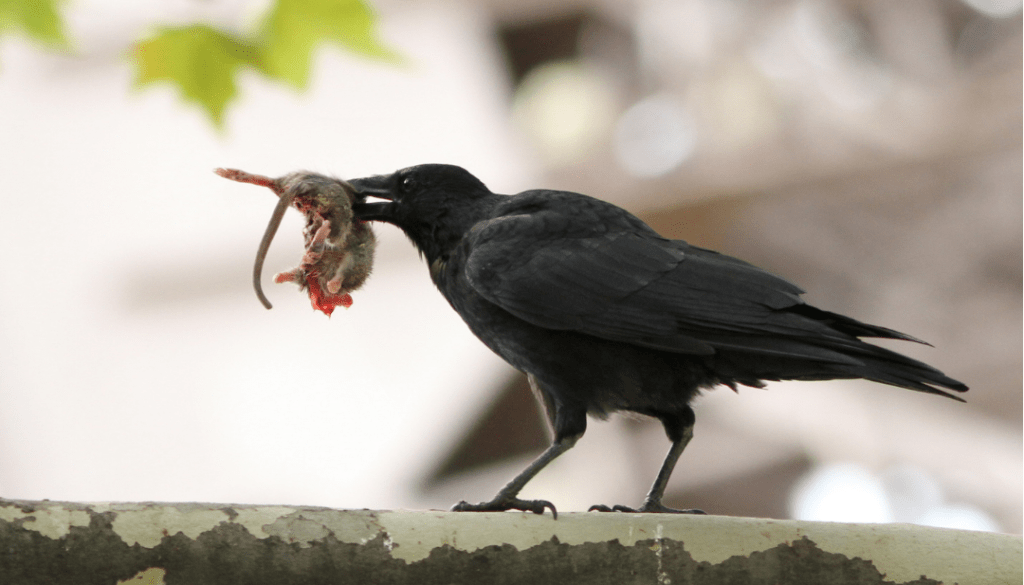Crows and rats are both opportunistic omnivores. In other words, if it looks like food and it’s small enough to swallow, they’ll give it a try.
Given the opportunity, rats will eat birds that are injured, small, weak, or already dead. Likewise, crows will eat rats that are in similarly vulnerable conditions.
Rats are larger than most live animals that crows prey on. Rather than hunting live rats, crows are more likely to scavenge on rats that are already dead. However, a crow may occasionally target a rat that’s very young, injured, or otherwise weak or defenseless.

Do Crows Hunt Live Prey?
Hunting live prey is one of several ways that crows find food. They also scavenge meat from already-dead animals, eat plant-based foods such as seeds and fruit, and pick through human garbage for edible bits.
Live prey options for crows are typically bite-sized organisms. Insects and worms are the standard options, along with the occasional lizard or baby bird.
Although they do consume some live prey, crows aren’t considered birds of prey. That group, also known as raptors, includes more powerful hunters such as eagles, hawks, falcons, and owls.
Crows are lacking these attributes that allow raptors to live on a carnivorous diet of large prey options:
- Large feet and sharp talons
- Hooked beak for ripping apart flesh
- Acute long-distance eyesight for spotting prey
- Fast and agile flying and striking skills
While crows aren’t built for big-game hunting, they’re smart enough to recognize unique feeding opportunities. Under the right circumstances, larger species such as rodents occasionally become viable prey options.
Do Crows Eat Mice?
You may also be wondering if crows eat mice? While it is much more common to see crows eating mice than rats it is still quite rare. Crows don’t seek out rodents to eat, but when they are available they make for a quick meal.
So yes, crows do eat mice, they are much easier to catch than rats due to their smaller size, and they can’t put up much of a fight. Poor mice…

When Would a Crow Eat a Rat?
Crows are both hunters and scavengers. In the case of relatively large animals like rats, crows are more likely to scavenge already-dead rats than to hunt live ones.
The most common rat species in North America are the Norway rat (also known as the brown rat or sewer rat) and the roof rat (also known as the black rat). Norway rats are the larger of the two.
From the head to the tail tip, a Norway rat can reach 16 inches in length and weigh about one pound—nearly as large as an adult crow.
Rats as Live Prey for Crows
A healthy adult rat is too big and feisty to be a practical meal choice for a crow. A rat would likely only catch a crow’s attention if it exhibits some sign of weakness.
A live rat might become a prey target if it’s:
- Very young
- Old, weak, and slow
- Injured or dying
Crows don’t engage in long-distance high-speed strikes in the manner of raptors like hawks and falcons. Rather, if a crow attacks a large mammal such as a rat, the process is likely to be slow and methodical.
A crow pursuing live mammal prey approaches with curiosity, hopping and pecking while judging the animal’s vulnerability.
The hunter may chase its prey from behind, staying out of harm’s way while attacking with its beak. The prey’s eyes may be targeted as a means of attacking the animal’s softest spot and rendering it defenseless.
Healthy adult mammals like rats and squirrels are faster on the ground than crows. In most cases, they would quickly evade the aggressor’s advances. If you see a crow pursuing a mammal, it’s likely that the animal is very young, sick, or injured.
Furthermore, crows don’t possess the physical tools to quickly kill mammals or tear apart their flesh for feeding. Therefore, it’s rare for a crow to take on a live mammal such as a rat that isn’t already injured, weak, or dying.
Rats as Scavenged Prey for Crows
Carrion (decaying dead animals) is a major food source for crows. Often, carrion comes in the form of roadkill.
Rats and crows are both frequent visitors to roadkill sites. There, they enjoy all the benefits of meat-eating without the hassle of hunting.
Of course, hanging around on the road makes scavengers likely to become motor vehicle victims themselves. As a result, crows and rats can end up on one another’s menu if they’re not careful.
However, crows have excellent environmental awareness. They’re usually able to navigate risky spots like roadkill sites.

Despite living lives full of danger, crows manage to avoid hazards that less intelligent animals might fall victim to. There’s no definitive research on the topic, but it’s likely that crows are better than most animals at learning to evade cars, thanks to their complex problem-solving skills.
Crows are bold, smart, and opportunistic. So, they’re well-suited for feeding on roadkill—without becoming roadkill themselves. That’s how unfortunate critters like dead rats usually end up on the crow menu.
Appreciating Bold and Brilliant Crows!
Crows are one of the world’s most intelligent species. They’re clever, creative problem solvers that thrive in dangerous human-filled habitats.
Live rats aren’t a typical food source for crows. However, crows are curious and brave, and they’ll eat whatever seems manageable. With millions of rats and crows coexisting in the same environments, some crow on rat predation and scavenging is inevitable.
Their eating habits might not always be pleasant to observe, but crows are incredible creatures. They live among us with boldness and confidence.
Spend some time observing crows, and you just might notice that they’re observing you, too. Crows have been known to recognize human faces, adapt to our behavior, and even offer gifts to humans that they favor.
To learn more about crows and their unique feeding habits, check out our article “Do Crows Eat Squirrels?”
Enjoy nature and Happy Birding!

James has always been an avid outdoorsman. Since a kid, he kept a journal of all the different birds and species he saw. Now he wants to share his passion with other birders with Happy Birding!
